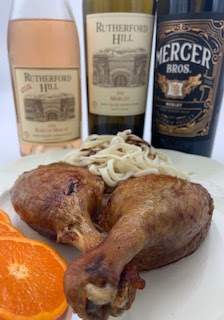 |
| Photo Credit:Italianwinecentral.com |
Lugana is located at the south shore of Italy’s largest lake, Lago di Garda, and lies partly in Veneto and partly in Lombardy. Its geo features a fairly flat basin bounded on the north by Lake Garda. On the west, south, and east, it’s surrounded by low morainic hills, which were formed by the southern push of the great Alpine glaciers of the Ice Age. The unique terroir in Lugana is formed by its uniform clay soils, temperature moderated by the large lake, and the confining hills.
Turbiana is the native signature grape of Lugana wines. To be qualified for the Lugana DOC, at least 90% of the grapes need to be Turbiana. While the styles of Lugana DOC wines vary from one producer to another, these wines, in general, are dry, lush, briny, and have the stronger mouthfeel that pairs well with fresh seafood that’s cooked with light sauces/seasonings or deep-fried in a light batter. The Cantonese way of cooking seafood exactly demonstrates the style of less-is-more, showcasing the seafood and discouraging any attempts to mask the ingredients' flavors with sauces.
 |
| Top L: Lobster Garlic Noodle, M: Sauteed Shrimp & Chicken, R: Baked Scallops with Crispy Seafood Rolls; Bottom: Assorted Seafood in a "basket" |
After tasting all six Lugana DOC wines, it was so hard to prefer one over another as they are all very good with subtle and nuanced differences that fascinate wine lovers. However, there are two standouts – Ca Dei Frati Brolettino Lugana DOC 2016 (SRP$27) and Tenuta Roveglia Lugana DOC Vend. Tard. Filo Di Arianna 2014 (SRP$17), which goes a bit above and beyond by offering the capacity of ageing or velvety texture as a result of late harvest respectively.
 |
| Cellaring Potential |
The Brolettino has been aged in oak for 10 months, showcasing mature citrus and tropical fruit. While the crushed limestone is still on the palate – typical of Lugana DOC wines, the lingering bittersweet lime, honey and almond at the finish was impressive. The complexity and structure of this wine go well with the creamier dishes such as baked scallops with crispy seafood rolls and steamed lobster with garlic over E-Fu noodle we had for the night. It also makes me want to cellar it to optimize its ageing potential.
 |
| Late Harvest Grapes Making the Arianna a Bit Sweeter |
The Arianna is produced using late-harvest 100% Turbiana which transcribes into a bit sweeter wine. It has the light vegetal and delicate nutty notes on the nose. On the palate, it reveals a hint of honey, ripe, juicy, candy fruit, but is balanced with elegant acidity. The mouthfeel is velvety with a salty and minerality finish. I loved this wine with the sautéed cuttlefish with vegetables as well as the assorted seafood in a “basket” as this wine works well with the peppery saltiness of the cuttlefish and the sweetness of the large scallops glazed with cornstarch in the “basket”. Speaking with this iconic dish in Cantonese banquet - assorted seafood in a “basket”, I have attempted to make it a few months back. My basket was made out of shredded taro instead of the rice vermicelli noddle.
For the rest of the Lugana DOC wines tasted, check out my brief notes below:
〰Cantina Bulgarini Lugana DOC 2017 (SRP$15): fresh, sapid, structured, intense, almond finish
〰Le Mortette Lugana DOC Mandolara 2017 (SRP$11): white flower, fruity, stone-fruit, delicate, bitter almond
〰Ca Maiol Lugana DOC Molin 2017 (SRP$17): pleasant acidity, refreshing, great structure, aromatic herbs, sharp finish
〰Cesari Cento Filari Lugana DOC 2016 (SRP$14): peach blossom, lemon, ginger note, green apple, almond finish
While Susannah called this July event, “Happiness Dinner”, I called it a pairing that’s seriously done right!































